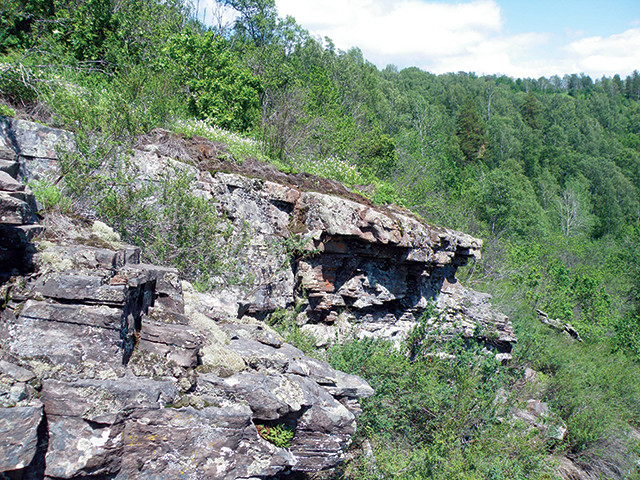
by Lucas Joel Thursday, June 16, 2016

A section of the Ediacaran-aged Zigan Formation in the Ural Mountains of Russia. The Zigan was sampled by Joseph Meert and his team for paleomagnetic signatures. Credit: Mikhail Bazhenov.
For about the first 3 billion years of life, the only living organisms on Earth were microscopic. The Ediacaran Period, between 635 million and 541 million years ago, saw the rise of the first large-scale life, most of which then went extinct at the period’s close — a collapse that scientists have yet to explain. Now, researchers may have found one of the extinction’s drivers: rapid flip-flopping of Earth’s magnetic field — wherein the field’s north and south poles reverse — that could have left the planet and Ediacaran organisms vulnerable to bombardment by harmful cosmic radiation.
In the new study, published in Gondwana Research, Joseph Meert, a geologist at the University of Florida, and his colleagues detail paleomagnetic signatures from the Ediacaran recorded in rocks now found along northern Russia’s Winter Coast, which lines part of the White Sea. “When we studied [the rocks], we realized the reversal frequency … was somewhat extraordinary,” Meert says. “It’s about 20 reversals per million years — that’s a conservative estimate — which is at least two to three times [the rate] that’s been seen since then.” (The last major reversal of Earth’s magnetic field is thought to have occurred about 781,000 years ago.)
The relative rapidity of the reversals, Meert says, means that the magnetic field, which helps protect against harmful ultraviolet radiation (specifically, UVB radiation) from the sun, would have been weakened. Typically, the field extends “about 10 Earth radii out toward the sun, but when you lose the magnetic field during a reversal, the magnetic shielding is reduced to about two Earth radii,” Meert says. Over a relatively short span of geologic time — starting about 550 million years ago and lasting until about 500 million years ago in the Cambrian — a weak magnetic shield would have allowed cosmic radiation to strip away the ozone layer that protects Earth from UVB radiation. In this environment, Ediacaran biota, which included many sessile, or immobile, organisms living in shallow ocean waters, would have been vulnerable to the increased radiation.
The rapid reversals probably “played an important role in the extinction of the Ediacarans,” Meert says. It is thought that the disappearance of the Ediacaran biota could have helped trigger the evolutionary explosion in the Cambrian, when most major animal groups first appeared in the fossil record. Without the Ediacarans dominating marine habitats, Cambrian fauna were able to proliferate. Why Cambrian fauna would not have been affected like Ediacaran fauna is another question: “If you’re being exposed to high UVB radiation, there are several ways to escape: one is to flee from sunlight, the other is to have some sort of naturally occurring sunscreen,” Meert says. It’s not known whether the Ediacarans emitted a natural sunscreen or not, he says, but a marked increase in vertical burrowing is only seen in the Cambrian, suggesting most Ediacaran organisms could not go into hiding underground. Organisms with hard shells — a feature that would have also helped block UVB radiation — also became more prevalent in the Cambrian.
Identifying what exactly caused the Ediacaran extinction, which helped spark the Cambrian Explosion, is one of the biggest questions in paleontology, says Bruce Lieberman, a paleontologist at the University of Kansas who was not involved in the study. “People have suggested in the past that there might’ve been an asteroid impact, while others have suggested that competition [between organisms] could’ve caused it,” Lieberman says. But, it could have also been caused by “bouts of radiation, and nobody has so nicely linked [that explanation] to what was going on with our own magnetic field on Earth,” he says. “That’s a real positive of this paper.”
The Ediacaran-Cambrian transition in the rock record has not been heavily sampled for paleomagnetism studies, Lieberman says. “More data are needed, and my hope would be that [this study] will inspire a search for more paleomagnetic records from this time, and also inspire additional research that looks at the connection between the paleomagnetic record and the history of life.”
© 2008-2021. All rights reserved. Any copying, redistribution or retransmission of any of the contents of this service without the expressed written permission of the American Geosciences Institute is expressly prohibited. Click here for all copyright requests.